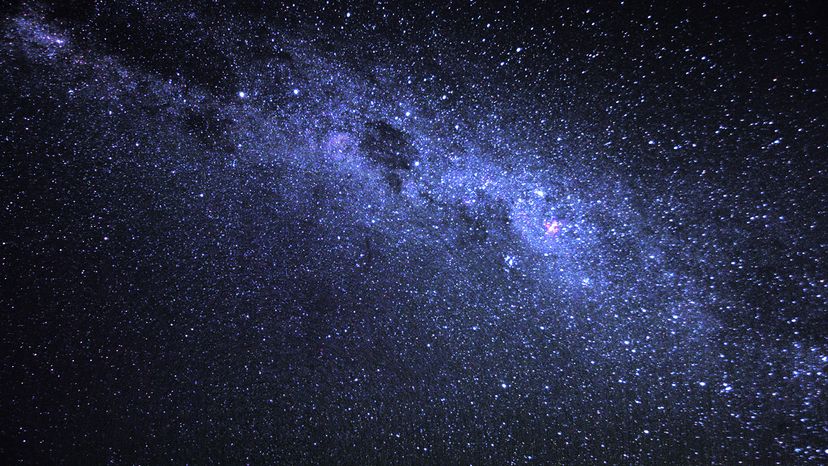You can best view the Milky Way from places with little or no light pollution. This photo was taken at Royal National Park in Sydney, Australia. Luke Peterson Photography / Getty Images
When you gaze up at the night sky, there’s a soft, sweeping band of light that is impossible to miss. This mesmerizing strip, evident near the horizon and arching across the expanse, has been a subject of human fascination for ages. The ancient Greeks named it “galaxies kuklos,” or “milk circle,” and the Romans dubbed it the “Milky Way.”
It was in the year 1610 that Galileo Galilei, with the aid of one of the first telescopes, began to decipher this celestial glow. His groundbreaking observations revealed a breathtaking fact: the Milky Way’s radiance is a result of billions of dim stars enveloping our cosmic vicinity.
With that pivotal revelation in mind, join us on a journey of discovery as we explore our very own galaxy. We’ll explore its size, shape and structure, discuss the movement of its stars and see how it compares to other galaxies.
Exploring the Milky Way From Inside the Galaxy
The Milky Way, our celestial home, has fascinated astronomers for centuries. It is a vast galaxy, a large system that includes stars, gas (predominantly hydrogen), dust and dark matter, all bound together by gravity.
As we navigate through the cosmos, an intriguing enigma emerges: What is the Milky Way truly like? What is it composed of, and what is its shape? These fundamental questions have puzzled astronomers for generations, and finding answers was no easy task.
One significant challenge arises from our unique perspective: We reside inside the Milky Way, which makes it hard to discern its form and contents. Early astronomers faced many limitations due to the technology of their time, including relatively small telescopes with limited range and magnification capabilities, which could only detect visible light.
On top of that, their view of the Milky Way was obstructed because it is shrouded in cosmic dust, akin to peering through a relentless dust storm. They once thought it contained all the stars in the sky.
Thankfully, the 20th century ushered in remarkable advancements in telescope technology, enabling astronomers to pierce through this celestial haze and peer deep into space. These powerful instruments unveiled an astonishing truth: The Milky Way is not a mere collection of stars but a galaxy with a graceful spiral shape. And contrary to popular belief, our solar system does not sit at the center of it.
This newfound knowledge highlights the sheer vastness of the universe, as the Milky Way is just one among countless galaxies that populate the cosmos. Now let’s look at some early theories about our humble galaxy.
Early Milky Way Theories
As we mentioned, Galileo discovered that the Milky Way is made of dim stars, which look less bright than other stars, either because they give off less light or because they’re far away from us.
So we know the composition of the galaxy, but what about its shape? How can you tell the shape of something if you’re inside it? In the late 1700s, astronomer Sir William Herschel addressed this question.
Herschel reasoned that if the Milky Way was a sphere, we should see numerous stars in all directions. So, he and his sister Caroline counted the all stars in more than 600 areas of the sky.
They found that there were more stars in the directions of the band of the Milky Way than above and below. Herschel concluded that the Milky Way was a disk-shaped structure. And because he found about the same numbers of stars in all directions along the disk, he concluded that the sun was near the center of the disk.
Around 1920, a Dutch astronomer named Jacobus Kapteyn measured the apparent distances to nearby and remote stars using the technique of parallax. Because parallax involved measuring the motions of stars, he compared the motions of distant stars with nearby ones.
He concluded that the Milky Way was a disc approximately 20 kiloparsecs, or 65,200 light-years, in diameter (one kiloparsec=about 3,260 light-years). Kapetyn also concluded that the sun was at or near the center of the Milky Way.
But future astronomers would question these ideas, and advanced technology would help them dispute the theories and come up with more accurate measurements.
Measuring Distances to the Stars
If you hold your thumb out at arm’s length and alternately open and close each eye, you’ll notice your thumb appears to shift against the background. This phenomenon is called a “parallax shift.” Astronomers observe a similar effect with stars due to Earth’s orbit.
By comparing star positions six months apart, they measure this parallax angle (Θ). Using Θ and Earth’s orbit radius (R), they calculate a star’s distance (D) as: D=RCotΘ. This is effective for stars within 50 parsecs. For farther stars, other methods involving luminosity are used.
Globular Clusters and Spiral Nebulae
Around the time that Kapteyn published his model of the Milky Way, his colleague Harlow Shapely noticed that a type of star cluster called a globular cluster had a unique distribution in the sky.
Although few globular clusters were found within the Milky Way band, there were a lot of them above and below it. Shapely decided to map the distribution of globular clusters and measure their distances using variable star markers within the clusters and the luminosity-distance relationship.
According to his observations, globular clusters were found in a spherical distribution and concentrated near the constellation of Sagittarius. Shapely concluded that the center of the galaxy was near Sagittarius, not the sun, and that the Milky Way was about 100 kiloparsecs in diameter.
Shapely was involved in a great debate about the nature of spiral nebulae (faint patches of light visible in the night sky). He believed that they were “island universes,” or galaxies outside the Milky Way. Another astronomer, Heber Curtis, believed that spiral nebulae were part of the Milky Way.
Edwin Hubble’s observations of Cepheid variables finally settled the debate — the nebulae were indeed outside the Milky Way.
But questions still remained. What shape was the Milky Way, and what exactly existed inside it?
What Shape Is the Milky Way?
Hubble studied galaxies and classified them into various types of elliptical and spiral galaxies. The spiral galaxies were characterized by disk shapes with spiral arms. It stood to reason that because the Milky Way was disk-shaped and spiral galaxies were disk-shaped, the Milky Way was probably a spiral galaxy.
In the 1930s, astronomer R.J. Trumpler realized that the estimates of the size of the Milky Way galaxy by Kapteyn and others were off because the measurements relied on observations in the visible wavelengths.
Trumpler concluded that the vast amounts of dust in the plane of the Milky Way absorbed light in the visible wavelengths and caused faraway stars and clusters to appear dimmer than they actually were. Therefore, to accurately map stars and star clusters within the disk of the Milky Way, astronomers would need a way to peer through the dust.
Enter the Radio Telescope
In the 1950s, the first radio telescopes were invented. Astronomers discovered that hydrogen atoms emitted radiation in the radio wavelengths and that these radio waves could penetrate the dust in the Milky Way.
So, it became possible to map each spiral arm of the Milky Way. The key was marker stars like those used in distance measurements. Astronomers found that class O and B stars would work. These stars had several features:
Brightness: They’re highly visible and often found in small groups or associations.Heat: They emit multiple wavelengths (visible, infrared, radio).Short life: They live for about 100 million years, so, considering the rate at which stars orbit the galaxy’s center, they don’t move far from where they were born.
Astronomers could use radio telescopes to accurately map the positions of these O and B stars, and use the Doppler shifts of the radio spectrum to determine their rates of motion. When they did this with many stars, they were able to produce combined radio and optical maps of the Milky Way’s spiral arms. Each arm is named for the constellations that exist within it.
Astronomers think that the motion of the material around the galactic center sets up density waves (areas of high and low density), much like you see when you stir cake batter with an electric mixer. These density waves are thought to cause the spiral nature of the galaxy.
So, by examining the sky in multiple wavelengths (radio, infrared, visible, ultraviolet, X-ray) with various ground- and space-based telescopes, we can get different views of the Milky Way.
The Doppler Effect
Much like the high-pitched sound from a fire-truck siren gets lower as the truck moves away, the movement of stars affects the wavelengths of light that we receive from them. This phenomenon is called the Doppler effect.
We can measure the Doppler effect by measuring lines in a star’s spectrum and comparing them to the spectrum of a standard lamp. The amount of the Doppler shift tells us how fast the star is moving relative to us.
In addition, the direction of the Doppler shift can tell us the direction of the star’s movement. If the spectrum of a star is shifted to the blue end, it is moving toward us; if the spectrum is shifted to the red end, the star is moving away from us.
Milky Way Structure
According to Hubble’s classification system, the Milky Way is a spiral galaxy, although more recent mapping evidence indicates that it may be a barred spiral galaxy.
The Milky Way has more than hundreds of billions of individual stars. It’s approximately 100,000 light-years in diameter, and the sun is located about 28,000 light years from the center. If we look at the structure of the Milky Way as it would appear from the outside, we can see certain parts.
Galactic Disk
The Milky Way’s disk consists of both old and young stars, with plentiful gas and dust. Stars in the disk orbit the galactic center in near-circular paths, with slight vertical motion due to gravitational interactions, resembling merry-go-round horses.
The disk has three regions: the nucleus at the center, the bulge around the nucleus extending slightly above and below the disk’s plane and the spiral arms radiating outward. Our solar system is located in one of these arms, specifically the Orion Arm. Other arms include the Perseus Arm, Sagittarius Arm and Scutum-Centaurus Arm.
Globular Clusters
Several hundred globular clusters are scattered above and below the plane of the galactic disk, orbiting the galactic center in elliptical paths with randomly scattered directions.
The stars within these clusters are significantly older compared to those in the galactic disk, and the clusters contain little to no gas and dust.
Halo
The halo, a large, dim area surrounding the galaxy, comprises hot gas, dark matter and old stars. Despite the apparent mass in the galaxy’s disk and center, rotation curve studies reveal most mass resides in the halo, hinting at dark matter’s presence.
The Milky Way’s gravity affects two satellite galaxies, the Large and Small Magellanic Clouds, visible from the Southern Hemisphere and orbiting at varying positions around our entire galaxy.
The Large Magellanic Cloud, about 14,000 light-years in diameter and 163,000 light-years away, may lose gas and dust to the Milky Way due to gravitational interactions.
Luminosity-distance Relationship
Astronomers use devices like photometers on telescopes to measure a star’s brightness. Knowing a star’s brightness and distance allows them to compute its luminosity using the formula: luminosity=brightness x 12.57 x (distance)².
Luminosity can also indicate a star’s distance from Earth. Stars like RR Lyrae and Cepheid variables, which change brightness predictably, serve as benchmarks.
To determine the luminosities of the globular clusters, Shapely measured the periods of brightness of the RR Lyrae stars in the clusters. Once he knew the luminosities, he could calculate their distances from Earth.
How Many Stars Are in the Milky Way?
We mentioned earlier that astronomers have estimated the number of stars in the Milky Way from measurements of the galaxy’s mass. But how do you measure the mass of a galaxy? You obviously can’t put it on a scale. Instead, you use its orbital motion.
From Newton’s version of Kepler’s Third Law of Planetary Motion, the orbital speed of an object in circular orbit and a little algebra, you can derive an equation to calculate the amount of mass (Mr) that lies within any circular orbit with a radius (r):
Orbital speed of a circular object (v) v=2Πa/pBecause it’s a circular orbit, a becomes radius (r) and M becomes the mass within that radius (Mr). Mr rv2/G
For the Milky Way, the sun lies at a distance of 2.6 x 10²⁰ meters (28,000 light-years) and has an orbital speed of 2.2 x 10⁵ meters/second (220 km/s), we get that 2 x 10⁴⁹ kg lies within the sun’s orbit.
Since the sun’s mass is 2 x 10³⁰, then there must be 10¹¹, or about 100 billion, solar masses (sunlike stars) within its orbit. When we add the portion of the Milky Way that lies outside the sun’s orbit, we get approximately 200 billion stars.
This article was updated in conjunction with AI technology, then fact-checked and edited by a HowStuffWorks editor.
Frequently Answered Questions
Where is Earth in the Milky Way?
Earth is in the Milky Way galaxy. It is about two-thirds of the way out from the center of the galaxy.
Lots More Information
HowStuffWorks Articles
Sources
A Map of the Milky Way. http://www.atlasoftheuniverse.com/milkyway.htmlA Teacher’s Guide to the Universe. http://www.astro.princeton.edu/~clark/teachersguide.htmlAmerican Museum of Natural History. “Our Place in Space the Milky Way Galaxy.” http://www.amnh.org/ology/astronomy/milkyway/index.htmArny, T.T. “Explorations an Introduction to Astronomy.” Mosby, 1994.Bennett, J. et al. “The Cosmic Perspective (third edition).” Pearson, 2004.Chaisson, E., McMillan, S. “Astronomy Today.” Prentice Hall, 2002.Discovery Education. Understanding the Universe: Galaxy Tour. http://school.discoveryeducation.com/schooladventures/universe/galaxytour/index.htmlHenry, J. Patrick et al. “The Evolution of Galaxy Clusters.” Scientific American, December 1998. http://atropos.as.arizona.edu/aiz/teaching/a204/darkmat/SciAm98b.pdfKaufmann, W.J. “Universe (fourth edition).” WH Freeman & Co., 1994.Multiwavelength Milky Way. http://mwmw.gsfc.nasa.gov/NASA Imagine the Universe. “The Hidden Lives of Galaxies” book. http://imagine.gsfc.nasa.gov/docs/teachers/galaxies/imagine/titlepage.htmlNASA Imagine the Universe. “The Hidden Lives of Galaxies” poster. http://imagine.gsfc.nasa.gov/docs/teachers/galaxies/imagine/poster.jpgNASA Imagine the Universe. “The Milky Way Galaxy.” http://imagine.gsfc.nasa.gov/docs/features/objects/milkyway1.htmlNASA/JPL GALEX. http://www.galex.caltech.eduSeeds, M.A. “Stars & Galaxies (second edition).” Brooks/Cole, 2001.Windows to the Universe. “The Milky Way Galaxy – Our Home.” http://www.windows.ucar.edu/tour/link=/the_universe/Milkyway.htmlWMAP Cosmology 101: The Milky Way Galaxy. http://map.gsfc.nasa.gov/m_uni/uni_101mw.html
Cite This!
Please copy/paste the following text to properly cite this HowStuffWorks.com article:
>>> Read full article>>>
Copyright for syndicated content belongs to the linked Source : How To Stuff – https://science.howstuffworks.com/milky-way.htm
































